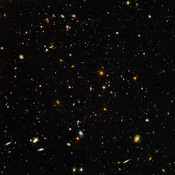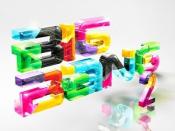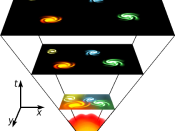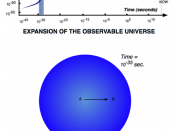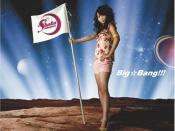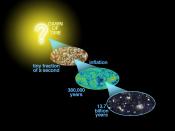Introduction A timeline is used to show when events have happened in history. With the "Big Bang" theory, people believe that the universe was formed 15 billion years ago when a cosmic explosion hurled matter in all directions. The Earth is a young planet and humans are the youngest creatures on it. In this lab, we will put together a history timeline that maps out life on Earth beginning with the Big Bang 15 billion years ago to the dawn of humans and other animals.
Hypothesis In doing this lab, I favor the impression of gradualism and I believe that is the way that life is started and ultimately improved. So, I expect that there is less life around the time closer to the Big Bang than there is in the time closer to the present day because life gets started from few things and then blossoms into many things.
As we get closer to today, there will be more plants and animals and other forms of life.
Materials and Methods The materials needed to perform this lab are a meter stick, three inch wide cash register tape, a dark marker, 38 cut out drawings of life up to 15 billion years ago, crayons, and glue. Measure out 15.5 meters of cash register tape and lay it out flat along the floor. Measure 25 centimeters from one end of the tape and mark that "Present Day" with the dark marker. Measure every 10 centimeters, which indicates 100 million years, and label it with a line. Do this until you reach the 5 meter mark; then change the markers to every 50 centimeters until you reach 15 billion years ago. Cut out and color the drawings and paste them on the correct accompanying date on the timeline. The last 1.5 meters of the timeline, nearing present day, gets kind of crowded, so just pasting a corner of each picture will suffice.
Results The results of this lab are very concise. There was plenty of life toward the end of the timeline; towards present day. There were around ten pictures clumped together between 200 million years ago (mya) and today. At the Big Bang, 15,000 mya, there was only one picture, which was the Big Bang, and the next picture after it wasn't until 10,000 mya which was nucleosynthesis. Pictures were randomly scattered after that and nearing present they started to get closer together.
Discussion Doing this history timeline was, maybe, the most tedious, disturbing, annoying thing I have ever done. First, the line itself is so long that it is hard to lug around with out it ripping, 15.5 meters is a long piece of register tape. Second, trying to measure on the ground was not fun and there was much room for measuring errors. Third, we messed up three times on labeling the dates. We couldn't get the dates to match up with present day and the big bang. Every time we thought we were doing it right we would jump like 700 million years, so then we would have to go back and fix it again. We had 3 different colored dated numbers by the time we were done. But, it just goes to show you that research on this type of stuff is not easy and will never be easy. You have to be oh so careful that you date everything as precisely as possible with little opportunity for error. I think if this lab was done again, it should all be done in one day and by "more grown-up" people. Now I am not saying that we are immature, but this was such a pain-staking process, that we just kind of got bored and unconcerned about the outcome of the lab.
